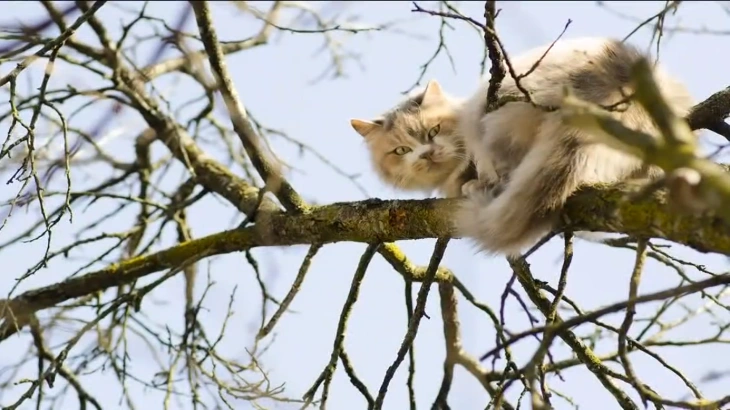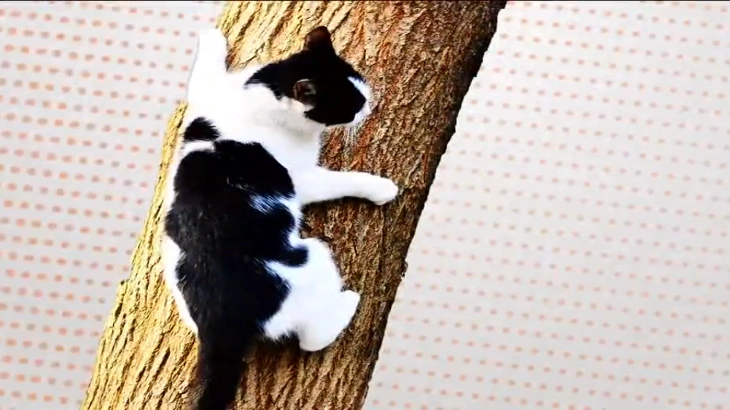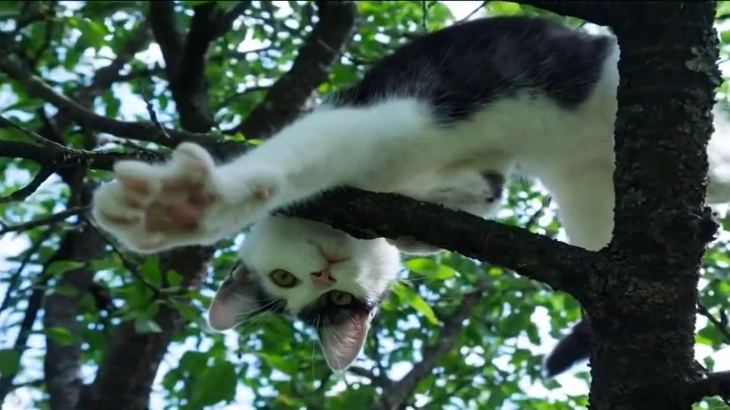Understanding Why Cats Can’t Get Down From Trees
By: Elizabeth Rikas

The information in this article is intended to educate cat parents and is not a substitute for veterinary guidance. In case of any concerns about your cat’s health, please talk with your veterinarian.
Cats are often seen climbing trees, and if you’ve ever had one get stuck up high, you might wonder why they struggle to get down. Understanding why do cats get stuck in trees involves exploring their unique climbing abilities, instincts, and physical anatomy. This insight can help cat owners ensure their furry friends stay safe and uninjured while exploring the great outdoors.
Also Read: Do Cats Get Jealous?
Are Cats Good Climbers?

Cats are agile creatures, designed for climbing. Their slender bodies, sharp claws, and flexible spines let them scale trees with ease. Here are a few reasons why climbing comes naturally to them:
- Sharp Claws: Cats have retractable claws that provide a strong grip on tree bark. This design allows them to climb upward quickly and efficiently.
- Flexible Spine: A cat’s spine is incredibly flexible, allowing them to twist and turn as they ascend to reach their desired height.
- Strong Hind Legs: Their powerful back legs provide the push needed for quick bursts of speed as they jump and climb.
These traits make cats excellent climbers, but they also play a role in their difficulty when it’s time to descend. While going up may be instinctual, getting down is another story.
Why Do Cats Get Stuck in Trees?

When it comes to getting down from a tree, cats face several challenges:
- Instinctual Behavior: Cats prefer to climb down face-first when they do descend. However, their instincts tell them to keep their backs to the tree trunk. This might make it difficult for them to judge distances or find stable footholds.
- Fear of Falling: When a cat sees that the height is significant, they may become hesitant or fearful. This fear can trigger a freeze response, leaving them clinging to the branches instead of moving down.
- Limited Visibility: The thick foliage of trees can hinder a cat’s ability to see the ground. They need to gauge how far down to leap, and this lack of visibility can make this task daunting.
- Soft Paws: While soft pads help with agility and quiet movement, they can limit a cat’s grip on smooth or slippery surfaces. When trying to navigate downward, this can impede their ability to secure themselves.
Related: Do Cats Like To Be Petted?
The Physical Anatomy Of Cats
The unique anatomy of cats is designed primarily for climbing up, not down. Their limb structure and bones are adapted for jumping up high, which supports their natural instincts as predators. Here’s a closer look:
- Joint Structure: The joints in a cat’s legs are flexible, which aids jumping upwards. However, this architectural setup may compromise their ability to manage tumbles or jumps downward effectively.
- Body Design: Cats’ slender bodies are built for height, not drop. Their center of gravity favors upward movement, adding to their discomfort when attempting to descend.
Related: How To Stop Cats From Peeing On Carpet?
How To Help A Cat Stuck In A Tree?
If your cat gets stuck in a tree, try these tips to assist them:
- Keep Calm: Make sure to stay calm and avoid startling your cat, as they may panic and climb higher.
- Coax Them Down: Use their favorite food or treats to coax them down. Sometimes, the smell of tuna or catnip can encourage them to come closer.
- Provide a Safe Route: If possible, create a safe climbing path using ladders or platforms to assist in their descent.
- Call for Help: If your cat seems truly stuck and panicked, don’t hesitate to seek help from local animal control or professional tree services.
Understanding why do cats get stuck in trees helps pet owners understand their feline friend’s natural instincts and limitations. By knowing the challenges they face and how to assist them safely, you can ensure your cat enjoys their outdoor adventures without fear or injury.
Next time you see your cat eyeing that tree, you might think twice before letting them leap up and explore. Their climbing prowess is impressive, but helping them back down safely is just as important!
Interesting Read: Why does my cat sleep between my legs?
Can I Climb Up To Rescue My Cat From A Tree?
If the cat remains stuck and you need to intervene, check your options carefully. Here are a few points to consider before climbing:
- Safety First: Make sure that you won’t put yourself in danger. Climbing a tree can be risky; ensure it’s sturdy and that you have a clear path down.
- Spotting a Safe Route: Look for branches that could support your weight while allowing you to reach the cat.
- Use Equipment Wisely: If the tree is tall, consider using a step ladder. This can make the task easier and safer.
- Reach Out for Help: If you feel unsure or the task seems too daunting, don’t hesitate to ask for help. Neighbors, friends, or family can provide assistance.
- Use Gentle Persuasion: If you do manage to reach the cat, avoid grabbing it suddenly. Instead, try persuading it down with soft, encouraging words or favorite treat.
- Consider the Weather: Weather can play a significant role in a cat’s decision to stay in a tree. If it’s cold, rainy, or windy, prompt action may be necessary.
Interesting Read: Sounds Cats Hate
Frequently Asked Questions
Final Thoughts
Cats are incredible climbers, but their sharp claws, designed for ascending, can make descending a real challenge. This can leave them feeling stuck and anxious high up in a tree. If you ever find your feline friend in this situation, remain calm and patient. Often, they’ll eventually make their way down on their own. However, if the situation persists, don’t hesitate to seek help from professionals. Understanding why cats sometimes get stuck in trees allows you to respond calmly and effectively, ensuring their safe return to the ground. With a little patience and understanding, you can help your adventurous cat navigate these tricky situations and return home safely.

About the Author
Elizabeth Rikas
Elizabeth is a passionate advocate for feline health and well-being, drawing from her years as a dedicated pet parent to three cats—Gypsy, Swan, and Alfred—and her invaluable experience volunteering at animal shelters. A seasoned writer with a lifelong love for cats, Elizabeth began sharing her insights in her teens and has since contributed extensively to platforms focused on feline care. Through her expertise and heartfelt dedication, she empowers pet owners with practical advice and research-backed knowledge to nurture their furry companions.
